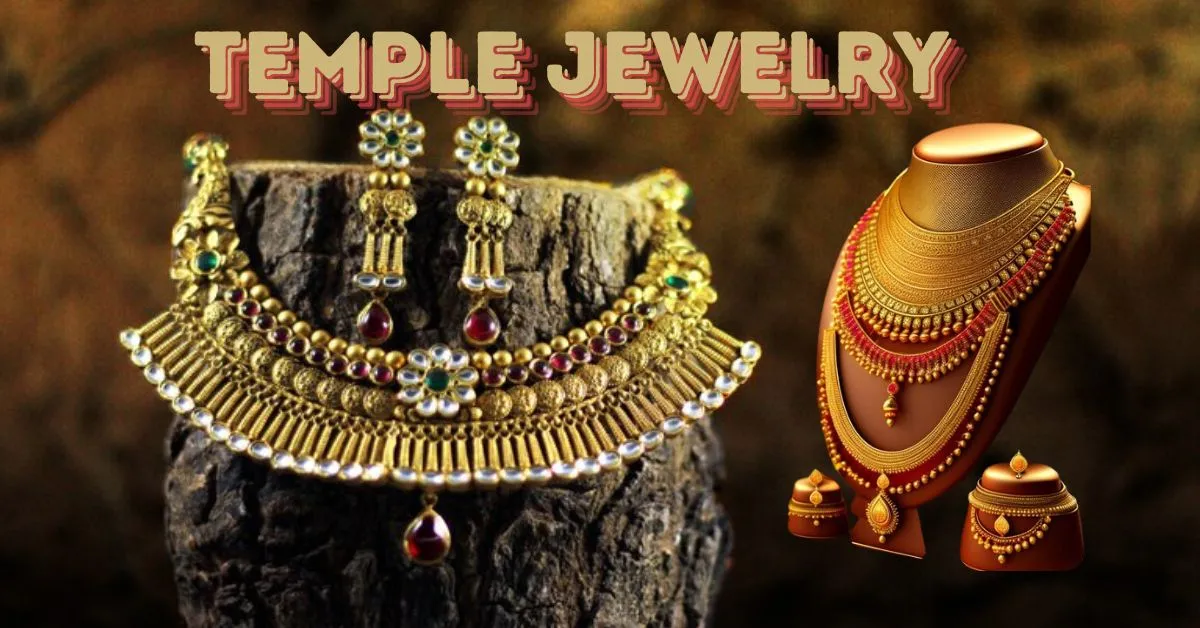Temple Jewelry Timeless Elegance and Spiritual Significance
Temple jewelry holds a significant place in Indian culture, blending intricate craftsmanship with deep spiritual symbolism. Originating from South India, this style of jewelry was traditionally crafted to adorn idols in temples during rituals and ceremonies. Over time, its exquisite designs and rich symbolism have made it a beloved choice for brides, classical dancers, and anyone seeking to embrace India’s cultural heritage.
What is Temple Jewelry?
Temple-jewelry encompasses a wide array of ornate pieces characterized by their elaborate designs and traditional motifs. These pieces are crafted using techniques passed down through generations of skilled artisans. They typically feature motifs inspired by Hindu gods and goddesses such as Lakshmi, Ganesha, peacocks, and lotus flowers. Each design element carries symbolic meaning, invoking blessings, protection, and auspiciousness.
Characteristics of Temple Jewelry
Temple jewelry is renowned for its:
Intricate Designs: Elaborate patterns and meticulous detailing that reflect the grandeur of ancient temple architecture.
Rich Materials: Traditionally crafted in gold or silver, often embellished with precious gemstones like rubies, emeralds, pearls, and uncut diamonds (polki).
Symbolic Significance: Each piece is imbued with spiritual meanings, offering wearers not just beauty but also a connection to their cultural roots and religious beliefs.
Popular Pieces of Temple Jewelry
Necklaces: Temple necklaces are statement pieces, often featuring layers of intricate chains with pendants or motifs of deities. They are worn prominently with traditional attire such as sarees and lehengas during weddings and festive occasions.
Earrings: Jhumkas are perhaps the most iconic earrings in temple-jewelry, characterized by their bell-like shape and intricate designs. Danglers, featuring motifs like peacocks or floral patterns, also add grace and elegance to any outfit.
Bangles and Bracelets: Meenakari work, a traditional enameling technique, adorns temple bangles and bracelets with vibrant colors and intricate designs. These pieces are essential in bridal trousseaus and are worn to symbolize prosperity and marital bliss.
Maang Tikka: A forehead ornament worn by brides, the Maang Tikka symbolizes the union of bride and groom and is believed to ward off evil. It often features a pendant with intricate detailing and may include gemstones for added brilliance.
Significance and Modern Appeal
Beyond their aesthetic appeal, temple jewelry holds deep cultural significance. It serves as a tangible link to India’s rich cultural heritage and religious traditions. In modern times, temple-jewelry has transcended its traditional role and gained popularity worldwide for its timeless beauty and craftsmanship.
Buying Temple Jewelry
When purchasing temple jewelry, consider these factors:
Authenticity: Look for pieces crafted by skilled artisans using traditional techniques handed down through generations.
Craftsmanship: Pay attention to the quality of craftsmanship, intricate detailing, and the use of genuine materials.
Occasion: Choose pieces that complement the occasion—whether it’s a grand wedding, a festive celebration, or everyday wear.
Maintenance: Proper care ensures longevity. Store temple-jewelry in a cool, dry place and avoid exposure to chemicals and moisture.
Conclusion
Temple jewelry is more than just adornment its a testament to Indias rich cultural tapestry and artistic legacy. Whether passed down as heirlooms or acquired for special occasions, each piece tells a story of craftsmanship, tradition, and spiritual devotion. Embrace the elegance and symbolism of temple-jewelry to connect with timeless traditions and celebrate the beauty of India’s cultural heritage.
FAQs
What is temple jewelry?
Temple jewelry refers to traditional Indian jewelry that originated in South India. It is characterized by intricate designs, typically featuring motifs inspired by Hindu gods and goddesses. Originally used to adorn idols in temples during rituals, temple-jewelry has become popular for its cultural significance and aesthetic appeal.
What are the materials used in temple jewelry?
Temple jewelry is traditionally crafted in gold or silver. It often includes embellishments such as pearls, rubies, emeralds, and uncut diamonds (polki). Some pieces also feature enamel work known as meenakari, which adds vibrant colors to the jewelry.
What are the symbolic meanings behind temple jewelry motifs?
Motifs in temple-jewelry carry deep symbolic significance. For example, the lotus flower symbolizes purity and divine beauty, while peacocks represent grace and spirituality. Depictions of Hindu gods and goddesses like Lakshmi (goddess of wealth) and Ganesha (god of beginnings) are believed to bring blessings and auspiciousness.
When is temple jewelry worn?
Temple-jewelry is worn on special occasions such as weddings, festivals, and religious ceremonies. It is an integral part of bridal attire in many Indian cultures and is also worn by classical dancers during performances.
Where can I buy authentic temple jewelry?
Authentic temple-jewelry can be purchased from reputable jewelry stores specializing in traditional Indian designs. Online platforms also offer a wide range of options, but it’s important to ensure the authenticity and craftsmanship of the piece before making a purchase.
Can temple-jewelry be customized?
Yes, temple jewelry can often be customized to suit personal preferences or specific occasions. Experienced jewelers can incorporate different gemstones, adjust sizes, or modify designs while retaining the traditional essence of temple jewelry.






